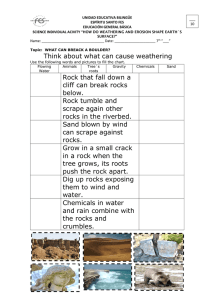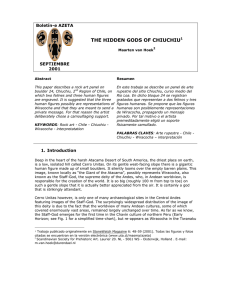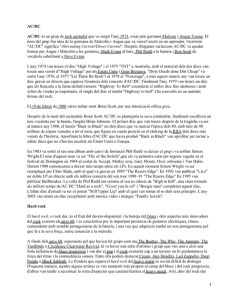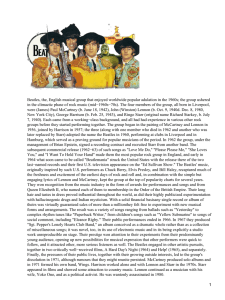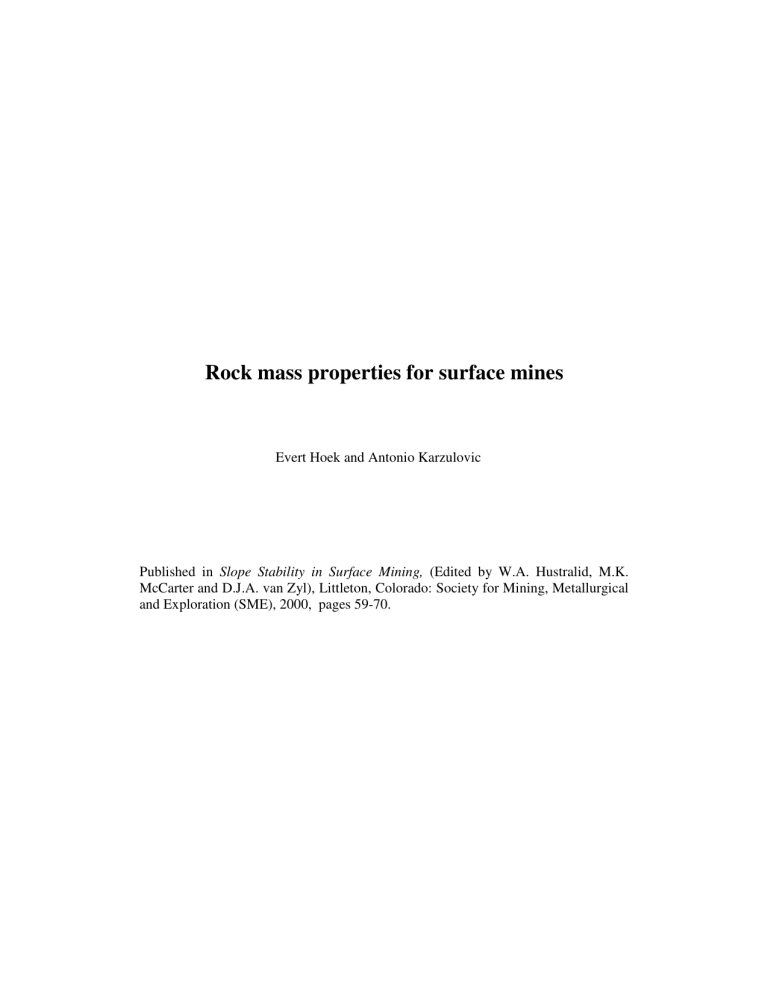
Rock mass properties for surface mines Evert Hoek and Antonio Karzulovic Published in Slope Stability in Surface Mining, (Edited by W.A. Hustralid, M.K. McCarter and D.J.A. van Zyl), Littleton, Colorado: Society for Mining, Metallurgical and Exploration (SME), 2000, pages 59-70. Page 2 Hoek-Brown criterion for surface mining Rock mass properties for surface mines Evert Hoek* and Antonio Karzulovic** 1.1 INTRODUCTION Reliable estimates of the strength and deformation characteristics of rock masses are required for almost any form of analysis used for the design of surface excavations. Hoek and Brown (1980a, 1980b) proposed a method for obtaining estimates of the strength of jointed rock masses, based upon an assessment of the interlocking of rock blocks and the condition of the surfaces between these blocks. This method was modified over the years in order to meet the needs of users who applied it to problems that were not considered when the original criterion was developed (Hoek 1983, Hoek and Brown 1988). The application of the method to very poor quality rock masses required further changes (Hoek, Wood and Shah 1992) and, eventually, the development of a new classification called the Geological Strength Index (Hoek 1994, Hoek, Kaiser and Bawden 1995, Hoek and Brown 1997, Hoek, Marinos and Benissi (1998)). A review of the development of the criterion and of the equations proposed at various stages in this development is given in Hoek and Brown (1997). This chapter presents the Hoek-Brown criterion in a form that has been found practical in the field and that appears to provide the most reliable set of results for use as input for methods of analysis currently used in rock engineering. For surface excavations, the rock mass properties are particularly sensitive to stress relief and blast damage and these two factors are discussed in his chapter. 1.2 GENERALISED HOEK-BROWN CRITERION The Generalised Hoek-Brown failure criterion for jointed rock masses is defined by: σ1' = σ 3' + σ ci σ' mb 3 + s σ ci a where σ1' and σ3' are the maximum and minimum effective stresses at failure, mb is the value of the Hoek-Brown constant m for the rock mass, s and a are constants which depend upon the rock mass characteristics, and σ ci is the uniaxial compressive strength of the intact rock pieces. * Consulting engineer, Vancouver, Canada. ** Professor, Department of Mining Engineering, University of Chile, Santiago, Chile (1.1) Hoek Brown criterion for surface mining Page 3 The Mohr envelope, relating normal and shear stresses, can be determined by the method proposed by Hoek and Brown (1980a). In this approach, equation 1.1 is used to generate a series of triaxial test values, simulating full scale field tests, and a statistical curve fitting process is used to derive an equivalent Mohr envelope defined by the equation: σ 'n − σ tm σ ci τ = Aσ ci B (1.2) where A and B are material constants σ 'n is the normal effective stress, and σ tm is the ‘tensile’ strength of the rock mass. In order to use the Hoek-Brown criterion for estimating the strength and deformability of jointed rock masses, three ‘properties’ of the rock mass have to be estimated. These are 1. the uniaxial compressive strength σ ci of the intact rock elements, 2. the value of the Hoek-Brown constant mi for these intact rock elements, and 3. the value of the Geological Strength Index GSI for the rock mass. 1.3 INTACT ROCK PROPERTIES For the intact rock pieces that make up the rock mass equation 1.1 simplifies to: σ1' = σ 3' + σ ci σ' mi 3 + 1 σ ci 0.5 (1.3) The relationship between the principal stresses at failure for a given rock is defined by two constants, the uniaxial compressive strength σ ci and a constant mi . Wherever possible the values of these constants should be determined by statistical analysis of the results of a set of triaxial tests on carefully prepared core samples. When laboratory tests are not possible, Table 1.1 and Table 1.2 can be used to obtain estimates of σ ci and mi . In the case of mineralised rocks, the effects of alteration can have a significant impact on the properties of the intact rock components and this should be taken into account in estimating the values of σ ci and mi . For example, the influence of quartzseritic alteration of andesite and porphyry is illustrated in the Figure 1.1. Similar trends have been observed for other forms of alteration and, where this type of effect is considered likely, the geotechnical engineer would be well advised to invest in a program of laboratory testing to establish the appropriate properties for the intact rock. Page 4 Hoek-Brown criterion for surface mining Percentage uniaxial compressive strength 100 Porphyry Andesite Quartz-monzonite porhpyry Andesite 80 60 40 20 0 Light Moderate Intense Very Intense Quartz -sericite alteration Figure 1.1: Influence of quartz-seritic alteration on the uniaxial compressive strength of “intact” specimens of andesite and porphyry. The Hoek-Brown failure criterion, which assumes isotropic rock and rock mass behaviour, should only be applied to those rock masses in which there are a sufficient number of closely spaced discontinuities, with similar surface characteristics, that isotropic behaviour involving failure on multiple discontinuities can be assumed. When the structure being analysed is large and the block size small in comparison, the rock mass can be treated as a Hoek-Brown material. Where the block size is of the same order as that of the structure being analysed or when one of the discontinuity sets is significantly weaker than the others, the HoekBrown criterion should not be used. In these cases, the stability of the structure should be analysed by considering failure mechanisms involving the sliding or rotation of blocks and wedges defined by intersecting structural features. Figure 1.2 summarises these statements in a graphical form. 1.4 GEOLOGICAL STRENGTH INDEX The strength of a jointed rock mass depends on the properties of the intact rock pieces and also upon the freedom of these pieces to slide and rotate under different stress conditions. This freedom is controlled by the geometrical shape of the intact rock pieces as well as the condition of the surfaces separating the pieces. Angular rock pieces with clean, rough discontinuity surfaces will result in a much stronger rock mass than one which contains rounded particles surrounded by weathered and altered material. Hoek Brown criterion for surface mining Page 5 Table 1.1: Field estimates of uniaxial compressive strength. Uniaxial Comp. Strength (MPa) > 250 Point Load Index (MPa) >10 Field estimate of strength Examples Specimen can only be chipped with a geological hammer Fresh basalt, chert, diabase, gneiss, granite, quartzite Grade* Term R6 Extremely Strong R5 Very strong 100 - 250 4 - 10 Specimen requires many Amphibolite, sandstone, blows of a geological basalt, gabbro, gneiss, hammer to fracture it granodiorite, peridotite , rhyolite, tuff R4 Strong 50 - 100 2-4 Specimen requires more than one blow of a geological hammer to fracture it Limestone, marble, sandstone, schist R3 Medium strong 25 - 50 1-2 Cannot be scraped or peeled with a pocket knife, specimen can be fractured with a single blow from a geological hammer Concete, phyllite, schist, siltstone R2 Weak 5 - 25 ** Can be peeled with a pocket knife with difficulty, shallow indentation made by firm blow with point of a geological hammer Chalk, claystone, potash, marl, siltstone, shale, rocksalt, R1 Very weak 1-5 ** Crumbles under firm blows with point of a geological hammer, can be peeled by a pocket knife Highly weathered or altered rock, shale R0 Extremely weak 0.25 - 1 ** Indented by thumbnail Stiff fault gouge * Grade according to Brown (1981). ** Point load tests on rocks with a uniaxial compressive strength below 25 MPa are likely to yield highly ambiguous results. Page 6 Hoek-Brown criterion for surface mining Table 1.2: Values of the constant mi for intact rock, by rock group. Note that values in parenthesis are estimates. Rock type Class Group SEDIMENTARY Clastic Carbonates NonClastic Texture Coarse Conglomerates ( 21 ± 3) Breccias (19 ± 5) Crystalline Limestone (12 ± 3) Medium Sandstones 17 ± 4 Sparitic Limestones ( 10 ± 2) Gypsum 8±2 Evaporites Fine Siltstones 7±2 Greywackes (18 ± 3) Micritic Limestones (9 ± 2 ) Anhydrite 12 ± 2 Chalk 7±2 METAMORPHIC Organic Non Foliated Marble 9±3 Hornfels (19 ± 4 ) Metasandstone (19 ± 3) Slightly foliated Migmatite (29 ± 3) Amphibolites 26 ± 6 Foliated* Gneiss 28 ± 5 Schists 12 ± 3 Light Plutonic IGNEOUS Dark Gabbro 27 ± 3 Norite 20 ± 5 Lava Volcanic Pyroclastic Quartzites 20 ± 3 Phyllites (7 ± 3) Slates 7±4 Granite Diorite 32 ± 3 25 ± 5 Granodiorite (29 ± 3) Dolerite (16 ± 5) Porphyries (20 ± 5) Hypabyssal Very fine Claystones 4±2 Shales (6 ± 2) Marls (7 ± 2) Dolomites (9 ± 3) Agglomerate (19 ± 3) Diabase (15 ± 5) Rhyolite (25 ± 5) Andesite 25 ± 5 Dacite (25 ± 3) Basalt (25 ± 5) Breccia (19 ± 5) Tuff (13 ± 5) Peridotite (25 ± 5) Obsidian (19 ± 3) * These values are for intact rock specimens tested normal to bedding or foliation. The value of mi will be significantly different if failure occurs along a weakness plane. Hoek Brown criterion for surface mining Page 7 Intact rock specimens - use equation 1.3 One joint set - do not use Hoek-Brown criterion Two joint sets - do not use Hoek-Brown criterion Many joints - use equation 1.1 with caution Heavily jointed rock mass - use equation 1.1 Figure 1.2: Idealised diagram showing the transition from intact to a heavily jointed rock mass with increasing sample size. The Geological Strength Index (GSI), introduced by Hoek (1994) and Hoek, Kaiser and Bawden (1995) provides a system for estimating the reduction in rock mass strength for different geological conditions. This system is presented in Table 1.3, for blocky rock masses, and Table 1.4 for schistose metamorphic rocks. Once the Geological Strength Index has been estimated, the parameters that describe the rock mass strength characteristics, are calculated as follows: mb = mi exp GSI − 100 28 (1.4) Page 8 Hoek-Brown criterion for surface mining For GSI > 25, i.e. rock masses of good to reasonable quality: s = exp GSI − 100 9 (1.5) and a = 0.5 (1.6) For GSI < 25, i.e. rock masses of very poor quality: s=0 and a = 0.65 − (1.7) GSI 200 (1.8) For better quality rock masses (GSI > 25), the value of GSI can be estimated directly from the 1976 version of Bieniawski’s Rock Mass Rating, with the Groundwater rating set to 10 (dry) and the Adjustment for Joint Orientation set to 0 (very favourable) (Bieniawski 1976). For very poor quality rock masses the value of RMR is very difficult to estimate and the balance between the ratings no longer gives a reliable basis for estimating rock mass strength. Consequently, Bieniawski’s RMR classification should not be used for estimating the GSI values for poor quality rock masses (RMR < 25) and the GSI charts should be used directly. If the 1989 version of Bieniawski’s RMR classification (Bieniawski 1989) is used, then GSI = RMR89’ - 5 where RMR89’ has the Groundwater rating set to 15 and the Adjustment for Joint Orientation set to zero. 1.5 MOHR-COULOMB PARAMETERS Most geotechnical software is written in terms of the Mohr-Coulomb failure criterion in which the rock mass strength is defined by the cohesive strength c′ and the angle of friction φ′. The linear relationship between the major and minor principal stresses, σ1' and σ 3' , for the Mohr-Coulomb criterion is σ1' = σ cm + kσ 3' (1.9) where σ cm is the uniaxial compressive strength of the rock mass and k is the slope of the line relating σ1' and σ3' . The values of φ′ and c′ can be calculated from sin φ ' = c' = k −1 k +1 σ cm (1 − sin φ ' ) 2 cos φ ' (1.10) (1.11) Hoek Brown criterion for surface mining Page 9 Table 1.3: Characterisation of a blocky rock masses on the basis of particle interlocking and discontinuity condition. After Hoek, Marinos and Benissi (1998). Page 10 Hoek-Brown criterion for surface mining Table 1.4: Characterisation of a schistose metamorphic rock masses on the basis of foliation and discontinuity condition. (After M. Truzman, 1999) Hoek Brown criterion for surface mining Page 11 There is no direct correlation between equation 1.9 and the non-linear Hoek-Brown criterion defined by equation 1.1. Consequently, determination of the values of c′ and φ′ for a rock mass that has been evaluated as a Hoek-Brown material is a difficult problem. Having considered a number of possible approaches, it has been concluded that the most practical solution is to treat the problem as an analysis of a set of full-scale triaxial strength tests. The results of such tests are simulated by using the HoekBrown equation 1.1 to generate a series of triaxial test values. Equation 1.9 is then fitted to these test results by linear regression analysis and the values of c′ and φ′ are determined from equations 1.11 and 1.10. A full discussion on the steps required to carry out this analysis is presented in the Appendix, together with a spreadsheet for implementing this analysis. The range of stresses used in the curve fitting process described above is very important. For the confined conditions surrounding tunnels at depths of more than about 30 m, the most reliable estimates are given by using a confining stress range from zero to 0.25 σ ci , where σ ci is the uniaxial compressive strength of the intact rock elements. For this stress range, the uniaxial compressive strength of the rock mass σ cm , the cohesive strength c and the friction angle φ are given in Figures 1.3 and 1.4. For slopes and shallow excavations the user is given the choice of the stress range for this curve fitting process. This is discussed in full in the Appendix. 1.0 Rock mass strength σcm / Intact strength σci 0.9 mi 0.8 35 30 0.7 25 0.6 0.5 0.4 0.3 20 15 0.2 10 5 0.1 0.0 0 10 20 30 40 50 60 70 80 90 100 Geological Strength Index GSI Figure 1.3: Ratio of uniaxial compressive strength of rock mass to intact rock versus Geological Strength Index GSI for depths of more than 30 m. Page 12 Hoek-Brown criterion for surface mining 0.10 0.08 0.06 0.05 0.04 0.03 mi 35 30 25 20 18 16 14 12 10 7 5 0.02 0.01 10 20 30 40 50 60 70 Cohesive strength / Uniaxial strength of intact rock 0.20 0.008 90 80 Geological Strength Index GSI a. Plot of ratio of cohesive strength c′ to uniaxial compressive strength σci for depths of more than 30 m. mi 55 35 30 25 20 18 16 14 12 10 50 Friction angle - degrees 45 40 35 7 30 5 25 20 15 10 10 20 30 40 50 60 70 80 90 Geological Strength Index GSI b. Plot of friction angle φ′ Figure 1.4: Cohesive strengths and friction angles for different GSI and mi values for depths of more than 30 m. Hoek Brown criterion for surface mining 1.6 Page 13 DEFORMATION MODULUS Serafim and Pereira (1983) proposed a relationship between the in situ modulus of deformation and Bieniawski’s RMR classification. This relationship is based upon back analysis of dam foundation deformations and it has been found to work well for better quality rocks. However, for many of the poor quality rocks it appears to predict deformation modulus values that are too high. Based upon practical observations and back analysis of excavation behaviour in poor quality rock masses, the following modification to Serafim and Pereira’s equation is proposed for σ ci < 100 : σ ci Em = 10 100 GSI −10 40 (1.12) Note that GSI has been substituted for RMR in this equation and that the modulus Em is reduced progressively as the value of σ ci falls below 100. This reduction is based upon the reasoning that the deformation of better quality rock masses is controlled by the discontinuities while, for poorer quality rock masses, the deformation of the intact rock pieces contributes to the overall deformation process. Based upon measured deformations, equation 1.12 appears to work reasonably well in those cases where it has been applied. However, as more field evidence is gathered it may be necessary to modify this relationship. σci = 100 MPa 180 Deformation modulus E - GPa 160 140 σci = 50 MPa 120 100 σci = 30MPa 80 σci = 15 MPa 60 σci = 10 MPa 40 σci = 5 MPa 20 σci = 1MPa 0 0 10 20 30 40 50 60 70 80 90 100 Geological Strength Index GSI Figure 1.5: Deformation modulus versus Geological Strength Index GSI. Page 14 1.7 Hoek-Brown criterion for surface mining STRESS RELAXATION When the rock mass adjacent to a tunnel wall or a slope is excavated, a relaxation of the confining stresses occurs and the remaining material is allowed to expand in volume or to dilate. This has a profound influence on the strength of the rock mass since, in jointed rocks, this strength is strongly dependent upon the interlocking between the intact rock particles that make up the rock mass. As far as the authors are aware, there is very little research evidence relating the amount of dilation to the strength of a rock mass. One set of observations that gives an indication of the loss of strength associated with dilation is derived from the support required to stabilise tunnels. Sakurai (1983) suggested that tunnels in which the ‘strain’, defined as the ratio of tunnel closure to tunnel diameter, exceeds 1% are likely to suffer significant instability unless adequately supported. This suggestion was confirmed in observations by Chern et al (1998) who recorded the behaviour of a number of tunnels excavated in Taiwan. They found that all of those tunnels that exhibited strains of greater than 1 to 2% required significant support. Tunnels exhibiting strains as high as 10% were successfully stabilised but the amount of effort required to achieve this stability increased in proportion to the amount of strain. While it is not possible to derive a direct relationship between rock mass strength and dilation from these observations, it is possible to conclude that the strength loss is significant. An unconfined surface that has deformed more than 1 or 2% (based upon Sakurai’s definition of strain) has probably reached residual strength in which all of the effective ‘cohesive’ strength of the rock mass has been lost. While there are no similar observations for rock slopes, it is reasonable to assume that a similar loss of strength occurs as a result of dilation. Hence, a 100 m high slope which has suffered a total crest displacement of more than 1 m (i.e. more than 1% strain) may start to exhibit significant signs of instability as a result of loss of strength of the rock mass. 1.8 BLAST DAMAGE Blast damage results in a loss of rock mass strength due to the creation of new fractures and the wedging open of existing fractures by the penetration of explosive gasses. In the case of very large open pit mine blasts, this damage can extend as much as 100 m behind the final row of blast holes. In contrast to the strength loss due to stress relaxation or dilation, discussed in the previous section, it is possible to arrive at an approximate quantification of the strength loss due to blast damage. This is because the blast is designed to achieve a specific purpose which is generally to produce a fractured rock mass that can be excavated by means of a given piece of equipment. Figure 1.6 presents a plot of 23 case histories of excavation by digging, ripping and blasting published by Abdullatif and Cruden (1983). These case histories are summarised in Table 1.5. The values of GSI are estimated from the data contained in the paper by Abdullatif and Cruden while the rock mass strength values were calculated by means of the spreadsheet given in the appendix, assuming an average slope height of 15 m. Hoek Brown criterion for surface mining Page 15 These examples shows that rock masses can be dug, obviously with increasing difficulty, up to GSI values of about 40 and rock mass strength values of about 1 MPa. Ripping can be used up to GSI values of about 60 and rock mass strength values of about 10 MPa, with two exceptions where heavy equipment was used to rip strong rock masses. Blasting was used for GSI values of more than 60 and rock mass strengths of more than about 15 MPa. Consider the case of an open pit slope excavated in granodiorite. The uniaxial compressive strength of the intact rock is σci = 60 MPa and the Geological Strength Index is GSI = 55. For granodiorite, Table 2 gives the value of mi = 30. Substitution of these values into the spreadsheet given in the appendix, for a single 18 m high bench, gives a rock mass strength σcm= 5.7 MPa. In order to create conditions for easy digging, the blast is designed to reduce the GSI value to below 40 and/or the rock mass strength to less than 1 MPa. In this case the controlling parameter is the rock mass strength and the spreadsheet given in the appendix shows that the GSI value has to be reduced to about 22 on order to achieve this rock mass strength. In another example of a 15 m high slope in weak sandstone, the compressive strength of the intact rock is σci = 10 MPa, mi = 17 and GSI = 60. These values give a rock mass strength σcm= 1.4 MPa and this is reduced to 0.7 by reducing the GSI to 40. Hence, in this case, both the conditions for efficient digging in this soft rock are satisfied by designing the blast to give a GSI value of 40. . 100 Rock mass strength σci - MPa Excavation method Dig Rip Blast 10 1 0.1 0 10 20 30 40 50 60 70 80 90 100 Geological Strength Index GSI Figure 1.6: Plot of rock mass strength versus GSI for different excavation methods, after Abdullatif and Cruden (1983). Page 16 Hoek-Brown criterion for surface mining Table 1.5: Summary of methods used to excavate rock masses with a range of uniaxial compressive strength values, based on data published by Abdullatif and Cruden (1983). Rock mass strength σ cm - MPa GSI 85 85 77 77 77 76 71 69 68 68 67 67 58 57 51 42 40 34 25 24 25 19 19 86 117 64 135 84 54 35 15 17 30 42 33 2.4 9.5 0.8 1.2 0.5 0.5 0.3 0.2 0.2 0.1 0.1 Excavation method Blasting Blasting Blasting Blasting Blasting Blasting Blasting Blasting Blasting Blasting Ripping by D9L bulldozer Ripping by D9L bulldozer Ripping by track loader Ripping by 977L track loader Ripping by track loader Digging by 977L track loader Digging by wheel loader Digging by hydraulic face shovel Digging by 977L track loader Digging by wheel loader Digging by hydraulic backhoe Digging by D9 bulldozer Digging by 977L track loader Figure 1.7: Diagrammatic representation of the transition between the in situ rock mass and blasted rock that is suitable for digging. Hoek Brown criterion for surface mining Page 17 Figure 1.7 summarises the conditions for a muckpile that can be dug efficiently and the blast damaged rock mass that lies between the digging limit and the in situ rock mass. The properties of this blast damaged rock mass will control the stability of the slope that remains after digging of the muckpile has been completed. The thickness D of the blast damaged zone will depend upon the design of the blast. Based upon experience, the authors suggest that the following approximate relationships can be used as a starting point in judging the extent of the blast damaged zone resulting from open pit mine production blasting: Large production blast, confined and with little or no control D = 2 to 2.5 H Production blast with no control but blasting to a free face D = 1 to 1.5 H Production blast, confined but with some control, e.g. one or more buffer rows D = 1 to 1.2 H Production blast with some control, e.g. one or more buffer rows, and blasting to a free face D = 0.5 to 1 H Carefully controlled production blast with a free face D = 0.3 to 0.5 H Page 18 1.9 Hoek-Brown criterion for surface mining REFERENCES Abdullatif, O.M. and Cruden, D.M. 1983. The relationship between rock mass quality and ease of excavation. Bull. Intnl. Assoc. Eng. Geol. No. 28. 183-187. Balmer G. 1952. A general analytical solution for Mohr's envelope. Am. Soc. Test. Mat. 52, 1260-1271. Bieniawski Z.T. 1976. Rock mass classification in rock engineering. In Exploration for Rock Engineering, Proc. of the Symp., (Edited by Bieniawski Z.T.) 1, 97-106. Cape Town, Balkema. Bieniawski Z.T. 1989. Engineering Rock Mass Classifications. p. 251. New York, Wiley. Brown E.T. (Ed). 1981. Rock characterization, testing and monitoring - ISRM suggested methods, 171-183. Oxford, Pergamon. Chern, J.C., Yu, C.W. and Shiao, F.Y. 1998. Tunnelling in squeezing ground and support estimation. Proc. Regional Symposium on Sedimentary Rock Engineering, Taipei. 192-202. Hoek E. 1994. Strength of rock and rock masses, ISRM News Journal, 2(2), 4-16. Hoek E. and Brown E.T. 1980. Underground excavations in rock, p. 527. London, Instn Min. Metall. Hoek E. and Brown E.T. 1988 The Hoek-Brown failure criterion - a 1988 update. In Rock Engineering for Underground Excavations, Proc. 15th Canadian Rock Mech. Symp. (Edited by Curran J.C.), 31-38. Toronto, Dept. Civil Engineering, University of Toronto. Hoek E. Strength of jointed rock masses, 1983. 23rd Rankine Lecture. Géotechnique 33(3), 187-223. Hoek E., Kaiser P.K. and Bawden W.F. 1995. Support of underground excavations in hard rock. p. 215. Rotterdam, Balkema. Hoek E., Wood D. and Shah S. 1992. A modified Hoek-Brown criterion for jointed rock masses. Proc. Rock Characterization, Symp. Int. Soc. Rock Mech.: Eurock ‘92, (Edited by Hudson J.A.), 209-214. London, Brit. Geotech. Soc. Hoek, E. and Brown, E.T. 1980. Empirical strength criterion for rock masses. J. Geotech. Engng. Div., ASCE, 106 (GT 9), 1013-1035. Hoek, E. and Brown, E.T. 1997. Practical estimates or rock mass strength. Int. J. Rock Mech. & Mining Sci. & Geomechanics Abstracts. 34(8), 1165-1186. Hoek, E., Marinos, P. and Benissi, M. 1998. Applicability of the Geological Strength Index (GSI) classification for very weak and sheared rock masses. The case of the Athens Schist Formation. Bull. Engg. Geol. Env. 57(2), 151-160. Sakurai, S. 1983. Displacement measurements associated with the design of underground openings. Proc. Intnl. Symp. Field Measurements in Geomechanics, Zurich. Vol. 2, 1163-1178. Hoek Brown criterion for surface mining Page 19 Serafim, J.L. and Pereira, J.P. 1983. Consideration of the Geomechanics Classification of Bieniawski. Proc. Intnl. Symp. Engng. Geol. And Underground Construction. Lisbon, Portugal, Vol. 1, Part 11, 33-44. Truzman, M, 1999, personal communication. Page 20 Hoek-Brown criterion for surface mining 1.10 APPENDIX – DETERMINATION OF MOHR COULOMB CONSTANTS The steps required to determine the parameters A, B, c′ and φ′ are given below. A spreadsheet for carrying out this analysis, with a listing of all the cell formulae, is given in Figure 1.8. The relationship between the normal and shear stresses can be expressed in terms of the corresponding principal effective stresses as suggested by Balmer (1952): σ 'n = σ 3' + σ1' − σ 3' (1.13) ∂σ1' ∂σ 3' + 1 τ = (σ1' − σ 3' ) ∂σ1' ∂σ 3' (1.14) For the GSI > 25, when a = 0.5: ∂σ1' ∂σ 3' = 1+ mb σ ci 2(σ1' − σ 3' ) (1.15) For GSI < 25, when s = 0: ∂σ1' = 1 + amba ' ∂σ 3 σ 3' σ ci a −1 (1.16) The tensile strength of the rock mass is calculated from: σ tm = σ ci mb − mb2 + 4 s 2 (1.17) The equivalent Mohr envelope, defined by equation 1.2, may be written in the form Y = log A + BX (1.18) where Y = log σ ' − σ tm τ , X = log n σ ci σ ci (1.19) Using the value of σ tm calculated from equation 1.17 and a range of values of τ and σ 'n calculated from equations 1.13 and 1.14 the values of A and B are determined by linear regression where : B= XY − ( X 2 Y) T X − ( X )2 T (1.20) Hoek Brown criterion for surface mining Page 21 A = 10^ ( Y T − B( X T ) ) (1.21) and T is the total number of data pairs included in the regression analysis. The most critical step in this process is the selection of the range of σ 3' values. As far as the authors are aware, there are no theoretically correct methods for choosing this range and a trial and error method, based upon practical compromise, has been used for selecting the range included in the spreadsheet presented in Figure 1.9. For a Mohr envelope defined by equation 1.2, the friction angle φi' for a specified normal stress σ 'ni is given by: φi' σ ' − σtm = arctan AB ni σ ci B −1 (1.22) The corresponding cohesive strength ci' is given by: c i' = τ − σ ' ni tan φ i' (1.23) and the corresponding uniaxial compressive strength of the rock mass is : σ cmi 2ci' cos φi' = 1 − sin φi' (1.24) The values of c′ and φ′ obtained from this analysis are very sensitive to the range of values of the minor principal stress σ3' used to generate the simulated full-scale triaxial test results. On the basis of trial and error, it has been found that the most consistent results for deep excavations (depth > 30 m below surface) are obtained when 8 equally spaced values of σ 3' are used in the range 0 < σ3′ < 0.25σci. For shallow excavations and slopes, the user should input the depth below surface of the anticipated failure surface and the unit weight of the rock mass. For typical slopes, the depth of the failure surface can be assumed to be equal to the slope height. Page 22 Hoek-Brown criterion for surface mining Figure 1.8: Spreadsheet for calculation of Hoek-Brown and equivalent MohrCoulomb parameters for shallow excavations and slopes. Input: sigci = 30 MPa mi = Depth of failure surface or tunnel below slope = Output: stress = a= B= coh = 0.68 0.5 0.7263 0.494 MPa MPa mb = sigtm = k= sigcm = 15 25 GSI = Unit wt. = m 3.01 -0.0672 MPa 9.19 3.00 MPa 55 0.027 s = 0.0067 A = 0.7086 phi = 53.48 E = 7304.0 Calculation: sig3 sig1 ds1ds3 sign tau x y xy xsq sig3sig1 sig3sq taucalc sig1sig3fit signtaufit 1E-10 2.46 19.32 0.12 0.53 -2.20 -1.75 3.85 4.85 0.00 0.00 0.53 3.00 0.66 0.10 3.94 12.74 0.38 1.00 -1.83 -1.48 2.71 3.35 0.38 0.01 1.00 3.88 1.00 0.19 5.04 10.31 0.62 1.38 -1.64 -1.34 2.19 2.69 0.97 0.04 1.37 4.77 1.33 0.29 5.96 8.95 0.86 1.70 -1.51 -1.25 1.88 2.28 1.72 0.08 1.70 5.65 1.65 0.39 6.78 8.06 1.09 2.00 -1.41 -1.18 1.66 2.00 2.61 0.15 2.00 6.54 1.97 0.48 7.52 7.41 1.32 2.28 -1.34 -1.12 1.49 1.78 3.63 0.23 2.28 7.42 2.28 0.58 8.21 6.91 1.54 2.54 -1.27 -1.07 1.36 1.61 4.75 0.33 2.54 8.31 2.58 Cell formulae: stress = if(depth>30, sigci*0.25,depth*unitwt*0.25) mb = mi*EXP((GSI-100)/28) s = IF(GSI>25,EXP((GSI-100)/9),0) a = IF(GSI>25,0.5,0.65-GSI/200) sigtm = 0.5*sigci*(mb-SQRT(mb^2+4*s)) sig3 = Start at 1E-10 (to avoid zero errors) and increment in 7 steps of stress/28 to stress/4 sig1 = sig3+sigci*(((mb*sig3)/sigci)+s)^a ds1ds3 = IF(GSI>25,(1+(mb*sigci)/(2*(sig1-sig3))),1+(a*mb^a)*(sig3/sigci)^(a-1)) sign = sig3+(sig1-sig3)/(1+ds1ds3) tau = (sign-sig3)*SQRT(ds1ds3) x = LOG((sign-sigtm)/sigci) y = LOG(tau/sigci) xy = x*y x sq = x^2 A = acalc = 10^(sumy/8 - bcalc*sumx/8) B = bcalc = (sumxy - (sumx*sumy)/8)/(sumxsq - (sumx^2)/8) k = (sumsig3sig1 - (sumsig3*sumsig1)/8)/(sumsig3sq-(sumsig3^2)/8) phi = ASIN((k-1)/(k+1))*180/PI() coh = sigcm/(2*SQRT(k)) sigcm = sumsig1/8 - k*sumsig3/8 E = IF(sigci>100,1000*10^((GSI-10)/40),SQRT(sigci/100)*1000*10^((GSI-10)/40)) phit = (ATAN(acalc*bcalc*((signt-sigtm)/sigci)^(bcalc-1)))*180/PI() coht = acalc*sigci*((signt-sigtm)/sigci)^bcalc-signt*TAN(phit*PI()/180) sig3sig1= sig3*sig1 sig3sq = sig3^2 taucalc = acalc*sigci*((sign-sigtm)/sigci)^bcalc s3sifit = sigcm+k*sig3 sntaufit = coh+sign*TAN(phi*PI()/180) 0.68 8.86 6.51 1.76 2.78 -1.21 -1.03 1.25 1.47 5.98 0.46 2.79 9.20 2.88 MN/n3 degrees MPa Sums 2.70 48.77 80.20 7.70 14.21 -12.42 -10.21 16.41 20.04 20 1
